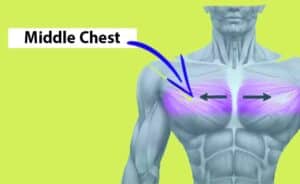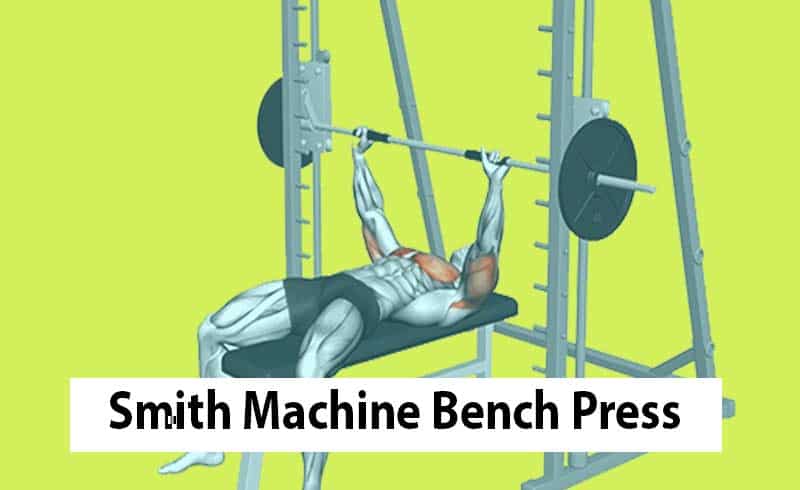Are you looking to target your chest and triceps effectively in your workout routine? The Smith Machine Bench Press is an excellent exercise to activate these muscle groups.
However, it’s crucial to perform the exercise with the correct setup and form to avoid injury and ensure optimal results.
In this guide, we’ll walk you through step-by-step instructions on How to Properly Perform the Smith Machine Bench Press for Maximum Gains, Muscles Worked, Benefits, and Tips.
Exercise Details:
| Specs | Details |
|---|---|
| Also Called | Smith Machine Press |
| Exercise Type | Weightlifting, Strength |
| Difficulty Level | For Beginners |
| Body Part | Upper Body |
| Main Targets | Chest |
| Secondary Targets | Shoulders, Triceps |
| Compound/Isolated | Compound |
| Force Type | Push |
| Equipment Required | Smith Machine, Barbell |
| Rest Time | 1-3 minutes |
Smith Machine Bench Press Muscle Worked
During a Smith Machine Bench Press, the following muscles are primarily worked:

Pectoralis Major (Chest Muscles):
Pectoralis major The upper chest’s large muscles are heavily used when bench pressing.
Their primary function is arm adduction, which includes bringing the arms closer to the body’s midline.
They also assist in the internal rotation of the arms.
Anterior Deltoid (Front Shoulder Muscles):
The three-headed muscle known as the Triceps Brachii is responsible for extending the arm at the elbow joint.
In the lockout portion of the bench press. Use an incline bench can further emphasize the involvement of the Anterior Deltoid during the bench press.
Triceps Brachii:
The Triceps Brachii, a three-headed muscle, is responsible for extending the arm at the elbow joint. It plays a crucial role in the lockout phase of the bench press.
Strengthening the triceps can significantly impact bench press performance, and exercises like the Tate press can be incorporated to target and enhance the triceps for improved bench press results.
How to Do the Smith Machine Bench Press Correctly
Step 1: Set Up the Smith Machine
Before jumping into the exercise, take a moment to set up the Smith Machine correctly. Follow these steps to ensure a proper setup:
Position the Bench: Ensure the bench is placed in the middle of the Smith Machine’s barbell. This placement ensures stability and prevents you from bending too far to the left or right during the exercise.
Align the Barbell: The barbell’s position is essential for targeting the right muscle groups and preventing unnecessary strain on your shoulders.
Step 2: Adjust Your Hand Position
Proper hand placement is crucial for maintaining balance and targeting the desired muscles. Follow these steps to adjust your hand position:
Sit Back: Sit back on the bench and get comfortable.
Shoulder Distance Apart: Position your hands on the barbell at least shoulder-distance apart. This width provides stability during the exercise.
Make Necessary Adjustments: Ensure the barbell is at the right height by adjusting the seat if needed. The barbell should be aligned laterally to the midline of your chest when you grip it.
Step 3: Perform the Smith Machine Bench Press
Now that the setup is complete, it’s time to perform the Smith Machine Bench Press:
Lie Back: Lay down on the bench with your back flat against it.
Position Hands: Grip the barbell firmly with your hands at shoulder width apart.
Arch Your Chest: Arch your chest slightly to engage the chest muscles fully.
Open Chin: Keep your chin up and chest open throughout the exercise.
Lower the Barbell: Slowly lower the barbell towards your chest while keeping your elbows in.
Press Up: Push the barbell back up to the starting position, fully extending your arms.
Breathe: Remember to breathe throughout the exercise. Inhale as you lower the barbell and exhale as you press it up.
Safety Tips:
- Use Safety Locks: The Smith Machine is equipped with safety locks. Before starting the exercise, ensure they are in place to prevent accidents.
- Start with Light Weights: If you’re new to the Smith Machine Bench Press, begin with light weights to familiarize yourself with the movement and prevent strain.
Tips For Bench Press Using Smith Machine
1. Maintain Slow Rep Timing and Controlled Weight:
This means you should perform each repetition (rep) of the exercise at a measured pace and not rush through it.
Controlling the weight throughout the set refers to maintaining steady and deliberate movements, both when lowering the barbell to your chest and when pushing it back up.
Avoiding sudden or jerky motions helps to engage the muscles more effectively and reduces the risk of injury.
2. Avoid Bouncing the Bar off Your Chest
You shouldn’t bounce the barbell off your chest when completing the bench press. instead, you should touch it to your chest.
Using the momentum of the weight to propel the bar back up, as opposed to your muscles’ strength. Bouncing can lead to improper muscle activation and potential strain on your joints.
3. No Locking Elbows at the Top of the Movement
When you reach the top of the bench press and fully extend your arms, avoid completely locking your elbows.
Locking the elbows means fully straightening them, which could cause unnecessary stress on the joint. Instead, maintain a slight bend in your elbows at the top position to keep tension on the muscles and reduce the risk of strain.
4. Opt for a Wider Grip to Target Chest, Not the Shoulders
Adjust your grip on the barbell to be wider than shoulder-width apart.
A wider grip helps to shift the emphasis of the exercise more onto your chest muscles (pectorals) and reduces the involvement of the front shoulder muscles (anterior deltoids).
This can be beneficial if you want to target your chest more specifically during the bench press.
Smith Machine Press Variations
1. Close-Grip Smith Machine Bench Press:
In this variation, place your hands closer together on the barbell, with your palms facing each other. This grip targets the triceps more intensely while also engaging the chest muscles.
The narrow hand placement puts more emphasis on the inner portion of the pectoral muscles.
2. Wide-Grip Smith Machine Bench Press:
In contrast to the close-grip, position your hands wider apart on the barbell, slightly wider than shoulder-width.
This grip shift focuses on the outer chest muscles, particularly the pectoralis major. The wide-grip variation also recruits more of the anterior deltoids.
3. Incline Smith Machine Bench Press:
Set the bench to an inclined angle (around 30-45 degrees) within the Smith Machine.
This variation targets the upper chest muscles more effectively.
By adjusting the bench angle, you engage the clavicular fibers of the pectoralis major, contributing to a well-rounded chest development.
4. Decline Smith Machine Bench Press:
Lower the bench to a decline position (around 15-30 degrees) to perform this variation.
The decline angle emphasizes the lower chest muscles and can help build depth and definition in that area.
Keep the barbell aligned with the lower chest to maximize the effectiveness of this exercise.
Conclusion:
The Smith Machine Bench Press is a valuable addition to your workout routine, targeting your chest and triceps effectively.
Remember to prioritize safety, start with manageable weights, and gradually increase the load as you become more confident in the exercise.
Sources & References:
- Comfort P, Haff GG, Suchomel TJ, Soriano MA, Pierce KC, Hornsby WG, Haff EE, Sommerfield LM, Chavda S, Morris SJ, Fry AC, Stone MH. National Strength and Conditioning Association Position Statement on Weightlifting for Sports Performance. J Strength Cond Res. 2023 Jun 1;37(6):1163-1190. doi: 10.1519/JSC.0000000000004476. Epub 2023 Mar 22. PMID: 36952649.
- Farias DA, Willardson JM, Paz GA, Bezerra ES, Miranda H. Maximal Strength Performance and Muscle Activation for the Bench Press and Triceps Extension Exercises Adopting Dumbbell, Barbell, and Machine Modalities Over Multiple Sets. J Strength Cond Res. 2017 Jul;31(7):1879-1887. doi: 10.1519/JSC.0000000000001651. PMID: 27669189.
- Saeterbakken AH, Stien N, Pedersen H, Solstad TEJ, Cumming KT, Andersen V. The Effect of Grip Width on Muscle Strength and Electromyographic Activity in Bench Press among Novice- and Resistance-Trained Men. Int J Environ Res Public Health. 2021 Jun 14;18(12):6444. doi: 10.3390/ijerph18126444. PMID: 34198674; PMCID: PMC8296276.
- Bench Press Calculator - April 22, 2024
- Press to Handstand: Ultimate Step-by-Step Guide - April 22, 2024
- Cable Press (How To Do, Benefits, Targeted Muscles, Alternative) - April 22, 2024

